With the delivery of 100MW of the Hi-MO5 bifacial module in mid-November 2020, the global cumulative shipments of LONGi bifacial modules reached 10GW. The value of the bifacial module has been widely recognized by the industry under LONGi’s leading promotion, furthermore bifacial module has become a mainstream solar product for utility-scale PV plants with an ever increasing market share. This paper will provide a detailed review of the development history and milestones for the LONGi bifacial module.
The evolution of LONGi’s bifacial module Epoch-defining product——Hi-MO 2
The PERT and HJT bifacial module based on N-type wafers had existed for some time, but had a limited market because of high cost. In 2017, LONGi and other PV companies released the P-type bifacial module based on a PERC cell. The LONGi Hi-MO2 module used 2+2 mm dual glass to reduce module weight and POE encapsulation to increase reliability. The adoption of a frame avoided damage to the module during installation and long-term use, meanwhile the design of a short frame without a C-side reduced shading on the cell’s rear side, thus enhancing energy yield. The Hi-MO2 module was installed at the Kubuqi (ELION) and Golmud power station (Huanghe Hydropower Development) projects following its release, achieving outstanding energy yield performance, thus promoting the use of bifacial modules in “Third Phase Top Runner” projects to reach a share of more than 40%.
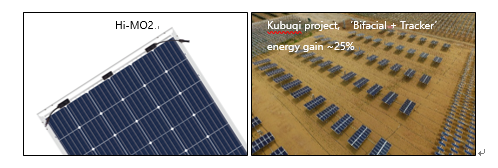
The introduction of half-cell technology——Hi-MO 3
LONGi released the Hi-MO3 module in 2018 by combining P-type mono-crystalline bifacial PERC technology with half-cell technology. Half-cell technology halves the operating current to significantly reduce internal loss and lower the module hot-spot temperature. White grid glass was used in Hi-MO3 to enhance front power, a solution proven to be more effective than transparent rear glass, based on comprehensive analysis of energy yield and BOS costs. Almost 275MWp of Hi-MO3 modules were installed at the Chinese Sihong “Top Runner” project following release.
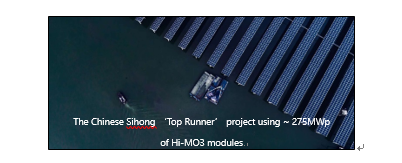
The global bestselling M6 module—Hi-MO 4
During the second half of 2018, different larger size wafers emerged in the industry. Following comprehensive analysis of compatibility with existing equipment, the supply capacity of glass and other materials and the product’s versatility in distributed and utility markets, LONGi launched in 2019 the M6 wafer standard (166mm side length) and Hi-MO4 module, based on the M6 wafer. Front power could reach 450W, bringing BOS costs down by over 0.7¢/W and making Hi-MO4 the bestselling among bifacial modules. LONGi’s adaptation of a new generation of POE encapsulation material increased the productivity of the bifacial module, narrowed the cost gap with monofacial and promoted bifacial’s wide application.
Best solution for ultra large power stations ——Hi-MO 5
With the rapid development of the PV industry, new build capacity was able to reach over 100GW in 2020 and it was already feasible to look beyond the compatibility of existing capacity to design larger size modules for large power stations. After a comprehensive analysis of the entire industry chain (module cost, BOS cost, transportation, installation, module reliability and energy yield), LONGi launched the Hi-MO5 module (2.82 m2 and 32.3kg) and announced the M10 standard wafer (182mm side length) together with 6 other PV companies. The Hi-MO5 module would provide the lowest LCOE solution for ultra large power stations and reset standardization in the PV industry.
The bifacial module’s energy yield advantages and global field verification
On the initial promotion of the bifacial module, the industry was unfamiliar with its potential application. LONGi carried out significant research into the mechanism of bifacial energy gain and made an enormous contribution to the technology’s popularization. LONGi research indicated that: In addition to receiving light reflected from the ground, the rear side of a bifacial module can also receive scattered light. The absorption of reflected light will be affected by the shadow of the module array, so factors such as module height, inter-row spacing, plane tilt and azimuth will also affect bifacial energy gain.
According to the mechanism of bifacial energy gain, LONGi made a number of suggestions for PV station design using bifacial modules:
- The ground albedo is the most important factor affecting bifacial gain. The order by albedo of common ground is: concrete & sand > dry land > grassland >water surface (LONGi confirmed that the albedo of water surface is relatively low, and the bifacial energy gain is about 3%).
- The bifacial module’s minimum ground clearance should not be less than 1m.
- If it is unavoidable to use mounts shading the rear side of the module, the distance between the steel purlins and module should not be less than 50mm, in order to reduce the adverse effect on bifacial energy gain.Avoid or reduce the shade of cable, combiner box or string inverter on the rear side of the module.
- A bifacial module can achieve over 15% energy gain by using white paint or laying a high reflectivity waterproof membrane on a flat roof.
- It is recommended to use bifacial modules in locations with snow, because the rear side yield gain will not be affected, and the operating heat can melt the snow on the front-side.
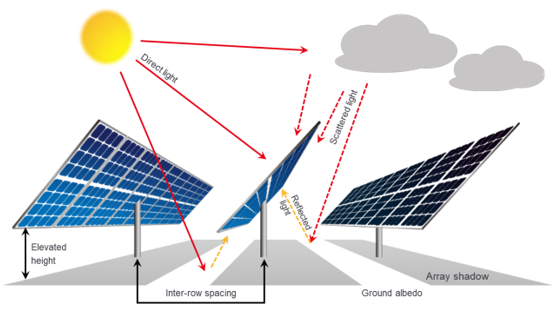
In order to specifically verify energy yield gain and stability of a P-type bifacial module under different scenarios and climatic conditions, LONGi cooperated with the China Electric Institute (CEI), B&V, TÜV SÜD, TÜV Rheinland, RETC and other institutions to build global pilot projects to evaluate the energy yield performance of bifacial modules. The results showed that:
- The energy gain of a LONGi bifacial module is consistent with theoretical expectation. Under reasonable installation conditions, the bifacial energy gain is positively correlated with the ground albedo.
- LONGi P-type bifacial and monofacial modules both meet first year degradation of < 2% under various scenarios and the bifaciality of bifacial modules remains stable (Confirmed the anti-LID and anti-PID performance of LONGi bifacial module).
- A bifacial module has better energy gain performance when matched with a tracking system. An advanced tracking system will optimize both front and rear side irradiation to maximize the overall energy yield of the module, while the bifacial energy gain will not be affected.
- Bifacial energy gain will be affected by scattered light, so it is stable at noon and apparently rises in the morning and evening. It will also be affected by azimuth, with bifacial gain higher in summer and lower in winter.
- Bifacial energy gain can be simulated by Pvsyst (Version 6.65).
- TÜV Rheinland pilot projects in India and Saudi Arabia have verified that the energy gain of a LONGi P-type bifacial module is very close to that of an N-type bifacial module, which proves its high cost performance.
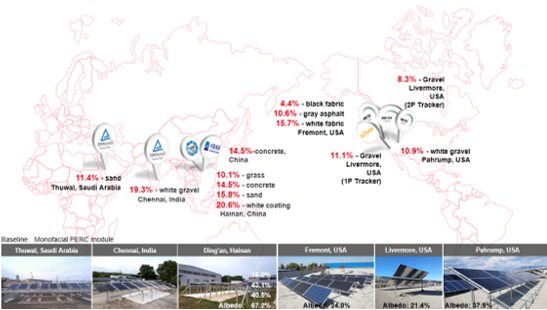
After the integration of half-cell technology with a bifacial module, LONGi continued to evaluate its energy yield and reliability at the China National Electric Apparatus Research Institute. Experimental data showed that a half-cell module has better energy yield than a full-cell module when radiation is higher, with the full-cell module having better yield when radiation is lower. The critical irradiation value is about 400W/m2 (excluding rear irradiation). The half-cell technology not only reduces the hot-spot risk of a module by reducing the operating current, but also enables the module to have better energy yield performance when used in regions around the world with abundant light resources.

The outstanding performance of the LONGi bifacial module
Based on high-quality wafers, high-efficiency PERC cells and strict requirements regarding module materials and processes, LONGi modules demonstrate excellent performance in third-party reliability tests, energy yield evaluations and client applications.
In 2019, RETC released its "PV Module Index" for the first time, based on the evaluation results of more than 2,500 modules from 46 crystalline silicon and thin-film module manufacturers. LONGi was one of only two companies to win the "High Achiever" award, based on the excellent performance of its modules in 18 indicators of reliability, performance and quality.
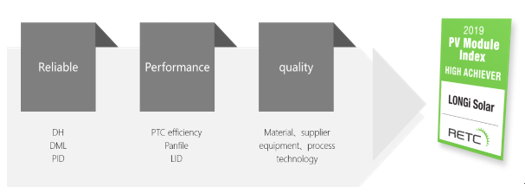
At TÜV Rheinland’s 2020 "All Quality Matters" awards event, LONGi bifacial modules were deemed to have performed best in outdoor power generation tests in an experimental field in Arizona, USA during the period from January 2018 to August 2019, winning the “Outdoor Energy Yield - Bifacial Group” award. In an outdoor power generation test organized by the PV magazine, LONGi bifacial modules were also placed first in energy yield rankings, their performance significantly ahead of all other participating modules.
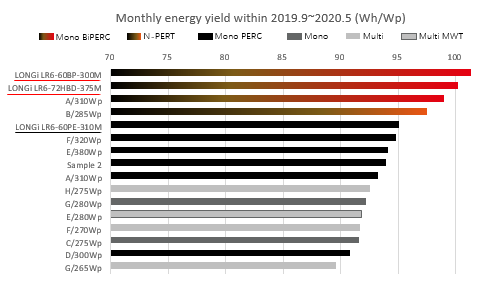
In the evaluation of energy yield gain of bifacial modules from different manufacturers on a 1P tracker by PVEL laboratory in the United States, LONGi modules were significantly higher than similar products from other manufacturers.

Summary
The development of the LONGi bifacial module has always been focused on customer value, fully considering the balance of cost, energy yield and product reliability. LONGi aims to deliver lower LCOE for large utility PV stations and, with the introduction of the Hi-MO5 module, is confident that shipments of its bifacial products will soon achieve a second 10GW milestone.